Optical and Electrochemical Applications of Li-Doped NiO Nanostructures Synthesized via Facile Microwave Technique
Abstract
1. Introduction
2. Materials and Methods
2.1. Synthesis of NiO Nanoparticles
2.2. Characterization
2.3. Preparation of Carbon Paste Electrode for Electrochemical Studies
2.4. Computational Details
3. Results and Discussion
3.1. XRD Analysis
3.2. Surface Morphology
3.3. Computational Studies
3.4. Diffuse Reflectance Spectral (DRS) Analysis
3.5. Photoluminescence Studies (PL)
3.6. Cyclic VoltammetryAnalysis
3.7. Impedance Studies
4. Conclusions
Author Contributions
Funding
Conflicts of Interest
References
- Yang, H.; Tao, Q.; Zhang, X.; Tang, A.; Ouyang, J. Solid-state synthesis and electrochemical property of SnO2-NiO nanomaterials. J. Alloys Compd. 2008, 459, 98. [Google Scholar] [CrossRef]
- Fujii, E.; Tomozawa, A.; Torii, H.; Takayama, R. Preferred orientations of NiO films prepared by plasma enhanced metal organic chemical vapor deposition. J. Appl. Phys. 1996, 35, 328. [Google Scholar] [CrossRef]
- Sato, H.; Minami, T.; Takata, S.; Yamada, T. Transparent conducting p-type NiO thin films prepared by magnetron sputtering. Thin Solid Films 1993, 236, 27. [Google Scholar] [CrossRef]
- Kitao, M.; Izawa, K.; Urabe, K.; Komatsu, T.; Kuwano, S.; Yamada, S. Preparation and electrochromic properties of RF-sputtered NiOx films prepared in Ar/O2/H2 atmosphere. J. Appl. Phys. 1994, 33, 6656. [Google Scholar] [CrossRef]
- Kumagai, H.; Matsumoto, M.; Toyoda, K.; Obara, M. Preparation and characteristics of nickel oxide thin film by controlled growth with sequential surface chemical reactions. J. Mater. Sci. Lett. 1996, 15, 1081. [Google Scholar] [CrossRef]
- Ellmer, K.; Mientus, R. Carrier transport in polycrystalline transparent conductive oxides: A comparative study of zinc oxide and indium oxide. Thin Solid Films 2008, 516, 4620. [Google Scholar] [CrossRef]
- Xiang, H.J.; Yang, J.; Hou, J.G.; Zhu, Q. Piezoelectricity in ZnO nanowires: A first principles study. Appl. Phys. Lett. 2006, 89, 223111. [Google Scholar] [CrossRef]
- Yi, J.B.; Lim, C.C.; Xing, G.Z.; Fan, H.M.; Van, L.H.; Huang, S.L.; Yang, K.S.; Huang, X.L.; Qin, X.B.; Wang, B.Y.; et al. Ferromagnetism in dilute magnetic semi-conductors through defect engineering: Li-doped ZnO. Phys. Rev. Lett. 2010, 104, 137201. [Google Scholar] [CrossRef]
- Guo, W.; Hui, K.N.; Hui, K.S. High conductivity nickel oxide thin films by a facile sol-gel method. Mater. Lett. 2013, 92, 291. [Google Scholar] [CrossRef]
- Jang, W.L.; Lu, Y.M.; Hwang, W.S.; Chen, W.C. Electrical properties of Li doped NiO films. J. Eur. Ceram. Soc. 2010, 30, 503–508. [Google Scholar] [CrossRef]
- Moulki, H.; Park, D.; Min, B.K.; Kwon, H.; Hwang, S.J.; HoChoy, J.; Toupance, T.; Campet, G.; Rougier, A. Improved electrochromic performances of NiO based thin films by lithium addition: From single layers to devices. Electrochim. Acta 2012, 74, 46. [Google Scholar] [CrossRef]
- Lakshmi Devi, L.; Jayasankar, C.K. Spectroscopic investigations on high efficiency deep red emitting Ca2SiO4:Eu3+ phosphors synthesized from agricultural waste. Ceram. Int. 2018, 44, 14063. [Google Scholar] [CrossRef]
- Furuya, S.; Nakano, H.; Yokoyoma, N.; Banno, H.; Fukuda, K. Enhancement of photoluminescence intensity and structural change by doping P5+ ion for Ca2-x/2(Si1-xPx)O4:Eu2+ green phosphor. J. Alloys Compd. 2016, 658, 147. [Google Scholar] [CrossRef]
- Nakano, H.; Kamimoto, K.; Yokoyama, N.; Fukuda, K. The effect of heat treatment on the emission color of P-doped Ca2SiO4 phosphor. Materials 2017, 10, 1000. [Google Scholar] [CrossRef]
- Rojas-Hernandez, R.E.; Rubio-Marcos, F.; Serrrano, A.; Salas, E.; Hussainova, I.; Fernandez, J.F. Towards blue long lasting luminescence of Eu/Nd-doped calcium aluminate nanostructured platelets via the molten salt route. Nanomaterials 2019, 9, 1473. [Google Scholar] [CrossRef]
- Shionoya, S.; Yen, W.M. Phosphor Handbook; CRC: Boca Raton, FL, USA, 1999; p. 579. [Google Scholar]
- Leskel, M. Rare earths in electroluminescent and field emission display phosphors. J. Alloys Compd. 1998, 275, 702. [Google Scholar] [CrossRef]
- Ortiz, A.; Falcony, C.; Hernandez, J.; Garcia, A.M.; Alonso, J.C. Photoluminescence characteristics of lithium doped zinc oxide films deposited by spray pyrolysis. Thin Solid Films 1997, 293, 103. [Google Scholar] [CrossRef]
- Ohashi, N.; Nakata, T.; Sekiguchi, T.; Hosono, H.; Mizuguchi, M.; Tsurumi, T.; Tanaka, J.; Haneda, H. Yellow emission from zinc oxide giving an electron spin resonance signal at g = 1.96. Jpn. J. Appl. Phys. 1999, 38, L113. [Google Scholar] [CrossRef]
- Fujihara, S.; Ogawa, Y.; Kasai, A. Tunable visible photoluminescence from ZnO thin films through Mg-doping and annealing. Chem. Mater. 2004, 16, 2965. [Google Scholar] [CrossRef]
- Mordkovich, V.Z.; Hayashi, H.; Haemori, M.; Fukumura, T.; Kawasaki, M. Discovery and optimization of new ZnO-based phosphors using a combinatorial method. Adver. Funct. Mater. 2003, 13, 519. [Google Scholar] [CrossRef]
- Lamrani, M.A.; Addou, M.; Sofiani, Z.; Sahraoui, B.; Ebothe, J.; Hichou, A.E.; Fellahi, N.; Bernede, J.C.; Dounia, R. Cathodoluminescent and nonlinear optical properties of undoped and erbium doped nanostructured ZnO films deposited by spray pyrolysis. Opt. Commun. 2007, 277, 196. [Google Scholar] [CrossRef]
- Jeevanandam, P.; Pulimi, V.R.R. Synthesis of nanocrystalline NiO by sol-gel and homogeneous precipitation methods. Indian J. Chem. 2012, 51A, 586. [Google Scholar]
- Benedict, S.; Singh, M.; Nail, T.R.R.; Shivashankar, S.A.; Bhat, N. Microwave synthesized NiO as a highly sensitive and selective room temperature NO2 sensor. ECS J. Solid State Sci. Technol. 2018, 7, Q3143. [Google Scholar] [CrossRef]
- Raj, R.A.; Alsalhi, M.S.; Devanesan, S. Microwave-assisted synthesis of nickel oxide nanoparticles using coriandrum sativum leaf extract and their structural-magnetic catalytic properties. Materials 2017, 10, 460. [Google Scholar] [CrossRef]
- Parada, C.A.; Moran, E. Microwave-assisted synthesis and magnetic study of nanosized Ni/NiO materials. Chem. Mater. 2006, 18, 2719. [Google Scholar] [CrossRef]
- Li, X.; Tan, J.F.; Hu, Y.E.; Huang, X.T. Microwave-assisted synthesis of Fe-doped NiO nanofoams assembled by porous nanosheets for fast response and recovery gas sensors. Mater. Res. Express 2017, 4, 045015. [Google Scholar] [CrossRef]
- Segall, M.D.; Lindan, J.; Peakard, C.J.; Hasnip, P.J.; Clark, S.J.; Payne, M.C. First principles simulation: Ideas, illustration and the CASTEP code. J. Phys. Cond. Matter 2002, 14, 2717. [Google Scholar] [CrossRef]
- Perdew, P.; Wang, Y. Accurate and simple density functional for the electronic exchange energy: Generalized gradient approximation. Phys. Rev. B 1986, 33, 8800. [Google Scholar] [CrossRef]
- Shanon, R.D. Revised effective ionic radii and systematic studies of interatomic distances in halides and chalcogenides. Acta Cryst. A 1976, 32, 751. [Google Scholar] [CrossRef]
- Chia, C.E.; Cheng-Fu, Y. Investigation of the properties of nanostructured Li-doped NiO films using the modified spray pyrolysis method. Nanoscale Res. Lett. 2013, 8, 33. [Google Scholar] [CrossRef]
- Matsubara, J.; Huang, S.; Iwamoto, M.; Pan, W. Enhanced conductivity and gating effect of p-type Li-doped NiO nanowires. Nanoscale 2014, 6, 688. [Google Scholar] [CrossRef] [PubMed]
- Bartel, L.C.; Morosin, B. Exchange striction in NiO. Phys. Rev. B 1971, 3, 1039. [Google Scholar] [CrossRef]
- Tasker, P.W.; Duffy, D.M. The structure and properties of stepped surfaces of MgO and NiO. Surf. Sci. 1984, 137, 91. [Google Scholar] [CrossRef]
- Xiang, J.; Xiang, B.; Cui, X. NiO nanoparticle surface energy studies using first principles calculations. New J. Chem. 2018, 42, 10791. [Google Scholar] [CrossRef]
- Tripathi, N.; Shyama, R. Facile synthesis of ZnO nanostructures and investigation of structural and optical properties. Mater. Char. 2013, 86, 263. [Google Scholar] [CrossRef]
- Pratapkumar, C.; Prashantha, S.C.; Nagabhushana, H.; Anilkumar, M.R.; Ravikumar, C.R.; Nagaswarupa, H.P.; Jnaneshwara, D.M. White light emitting magnesium aluminate nanophosphor: Near ultra violet excited photoluminescence, photometric characteristics and its UV photocatalytic activity. J. Alloys Compd. 2017, 728, 1124. [Google Scholar] [CrossRef]
- Lopez, R.; Gomez, R. Band-gap energy estimation from diffuse reflectance measurements on sol-gel and commercial TiO2: A comparative study. J. Sol–Gel Sci. Technol. 2012, 61, 1. [Google Scholar] [CrossRef]
- Saha, B.; Das, S.; Chattopadhyay, K.K. Electrical and optical properties of Al doped cadmium oxide thin films deposited by radio frequency magnetron sputtering. Solar Energy Mater. Sol. Cel. 2007, 91, 1692. [Google Scholar] [CrossRef]
- Ikeda, K.; Vedanand, S. Optical spectrum of synthetic theophrastite Ni(OH)2. Neues Jahrb. Mineral. Monatsh. 1999, 1, 21. [Google Scholar]
- Gandhi, A.C.; Wu, S.Y. Strong deep-level-emission photoluminescence in NiO nanoparticles. Nanomaterials 2017, 7, 231. [Google Scholar] [CrossRef]
- Musevi, S.J.; Aslani, A.; Motahari, H.; Salimi, H. Offer a novel method for size appraise of NiO nanoparticles by PL analysis: Synthesis by sonochemical method. J. Saudi Chem. Soc. 2016, 20, 245. [Google Scholar] [CrossRef]
- Anandan, K.; Rajendran, V. Morphological and size effects of NiO nanoparticles via solvothermal process and their optical properties. Mater. Sci. Semicond. Process 2011, 14, 43. [Google Scholar] [CrossRef]
- Jiang, D.Y.; Qin, J.M.; Wang, X.; Gao, S.; Liang, Q.C.; Zhao, J.X. Optical properties of nickel oxide thin films fabricated by electron beam evaporation. Vacuum 2012, 86, 1083. [Google Scholar] [CrossRef]
- Madhu, G.; Biju, V. Effect of Ni2+ and O2− vacancies on the electrical and optical properties of nanostructured nickel oxide synthesized through a facile chemical route. Physica E 2014, 60, 200. [Google Scholar] [CrossRef]
- Chen, H.R.; Harding, J.H. Nature of the hole states in Li-doped NiO. Phys. Rev. B 2012, 85, 115127. [Google Scholar] [CrossRef]
- Jain, S.; Khare, P.S.; Pandey, D.K. Synthesis and analysis of photoluminescence properties of In and Sn doped nickel oxide powders. Optik 2016, 127, 6763. [Google Scholar] [CrossRef]
- Wang, Y.; Ma, C.; Sun, X.; Li, H. Preparation and photoluminescence properties of organic-inorganic nanocomposite with a mesolamellar nickel oxide. Microporous Mesoporous Mater. 2004, 71, 99. [Google Scholar] [CrossRef]
- Zou, B.; Xiao, L.; Li, T.J.; Zhao, J.; Lai, Z.; Gu, S. Absorption redshift in TiO2 ultrafine particles with surficial dipole layer. Appl. Phys. Lett. 1991, 59, 1826. [Google Scholar] [CrossRef]
- Bai, N.; Li, S.G.; Chen, H.Y.; Peng, W.Q. Preparation, characterization and photoluminescence properties of mesolamellar titanium dioxide films. Mater. Chem. 2001, 11, 3099. [Google Scholar] [CrossRef]
- Bernard, M.C.; Cortes, R.; Keddam, M.; Takenouti, H.; Bernard, P.; Senyarich, S. Structural defects and electrochemical reactivity of β-Ni(OH)2. J. Power Sources 1996, 63, 247. [Google Scholar] [CrossRef]
- Baraldi, P.; Davolio, G. An electrochemical and spectral study of the nickel oxide electrode. Mater. Chem. Phys. 1989, 21, 143. [Google Scholar] [CrossRef]
- Ravikumar, C.R.; Anil Kumar, M.R.; Nagaswarupa, H.P.; Prashantha, S.C.; Bhatt, A.S.; Santosh, M.S.; Kuznetsov, D. CuO embedded β-Ni(OH)2 nanocomposite as advanced electrode materials for supercapacitors. J. Alloys Compd. 2018, 736, 332–339. [Google Scholar] [CrossRef]
- Bard, A.J.; Faulkner, L.R. Electrochemical Methods: Fundamentals and App, 2nd ed.; John Wiley and Sons: Hoboken, NJ, USA, 2000; p. 368. [Google Scholar]
- Brug, G.J.; Eeden, V.D.; Sluyters-Rehobach, M.; Sluyters, J.H. The analysis of electrode impedances complicated by the presence of a constant phase element. J. Electroanal. Chem. 1984, 176, 275. [Google Scholar] [CrossRef]
- Masarapu, C.; Zeng, H.F.; Hung, K.H.; Wei, B. Effect of temperature on the capacitance of carbon nanotube capacitors. ACS Nano 2009, 3, 2199. [Google Scholar] [CrossRef]
- Yen Ho, M.; Khiew, S.P.; Isa, D.; Chiu, W.S. Electrochemical studies on nanometal oxide-activated carbon composite electrodes for aqueous supercapacitors. Funct. Mater. Lett. 2014, 7, 1440012. [Google Scholar] [CrossRef]
- Avinash, B.; Ravikumar, C.R.; Anil Kumar, M.R.; Nagaswarupa, H.P.; Santosh, M.S.; Bhatt, A.S.; Kuznetsov, D. Nano CuO: Electrochemical sensor for the determination of paracetamol and D-glucose. J. Phys. Chem. Solids 2019, 134, 193. [Google Scholar] [CrossRef]
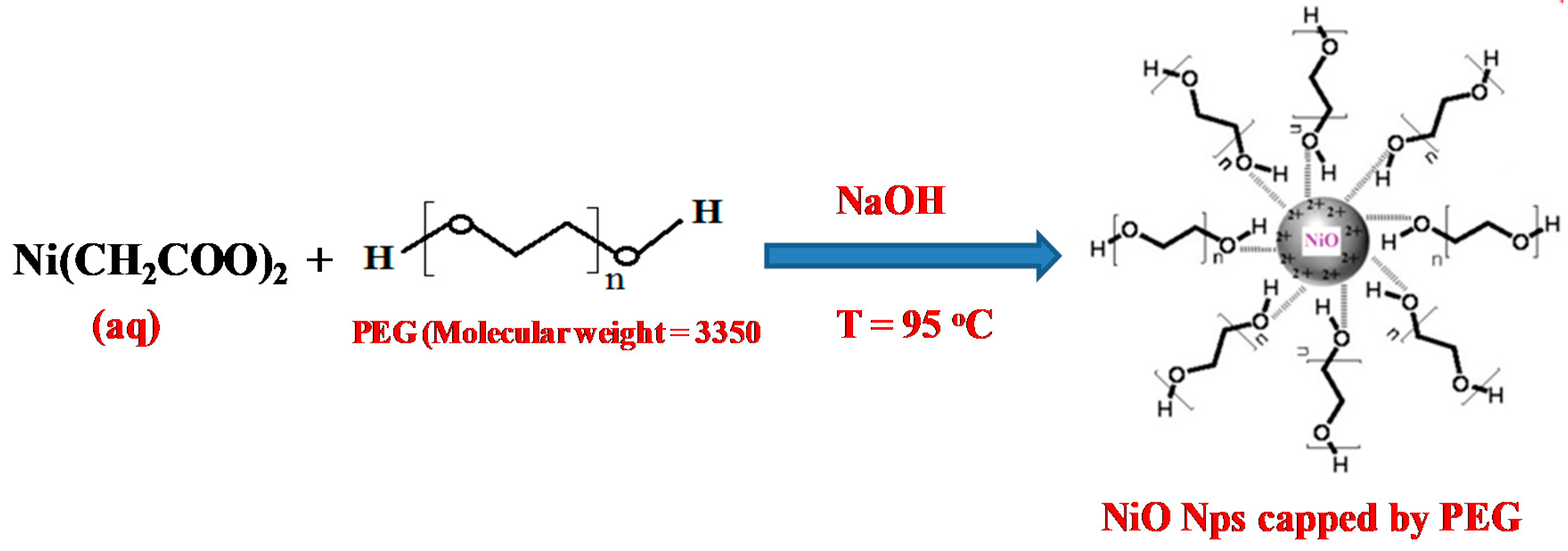

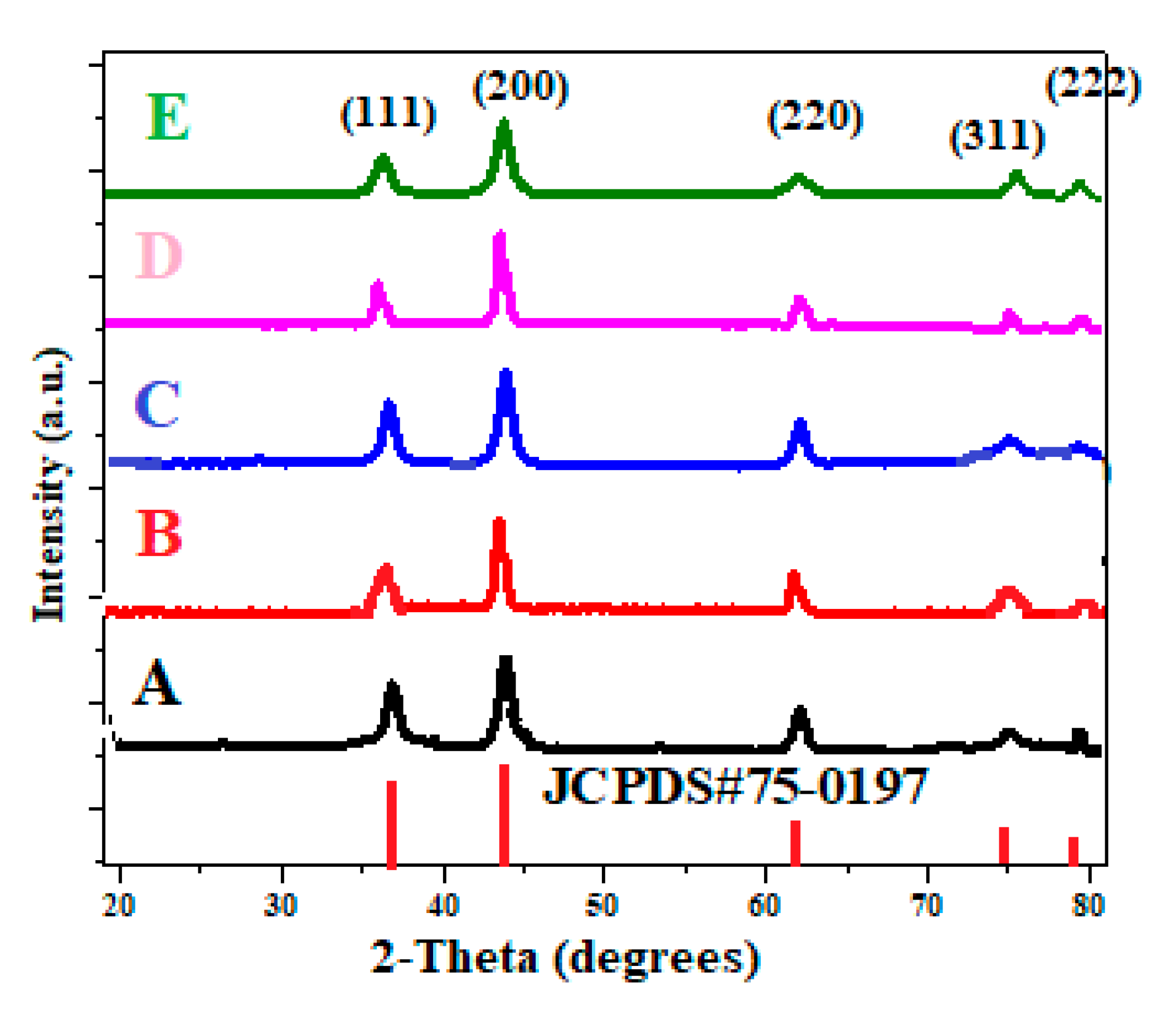
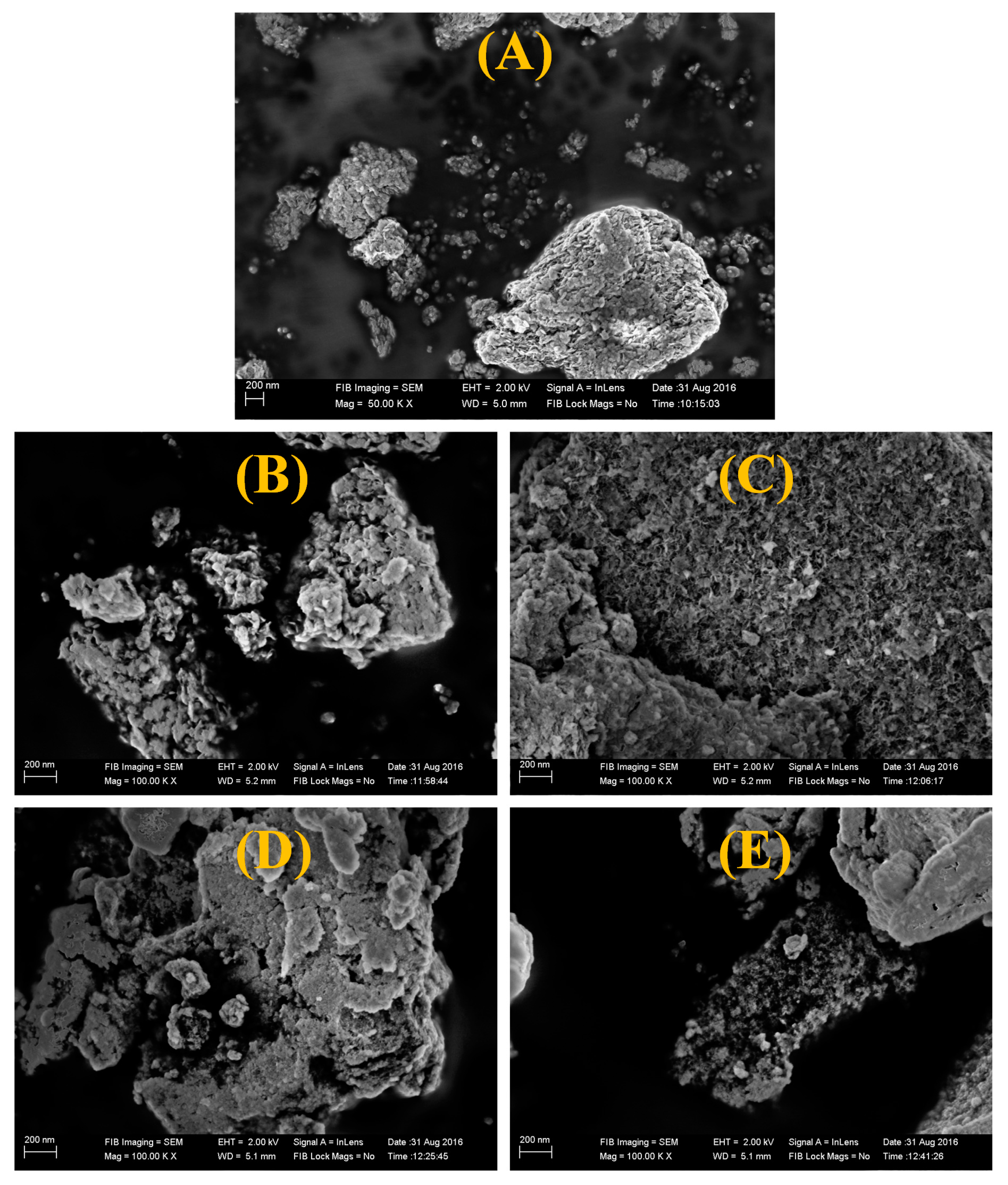
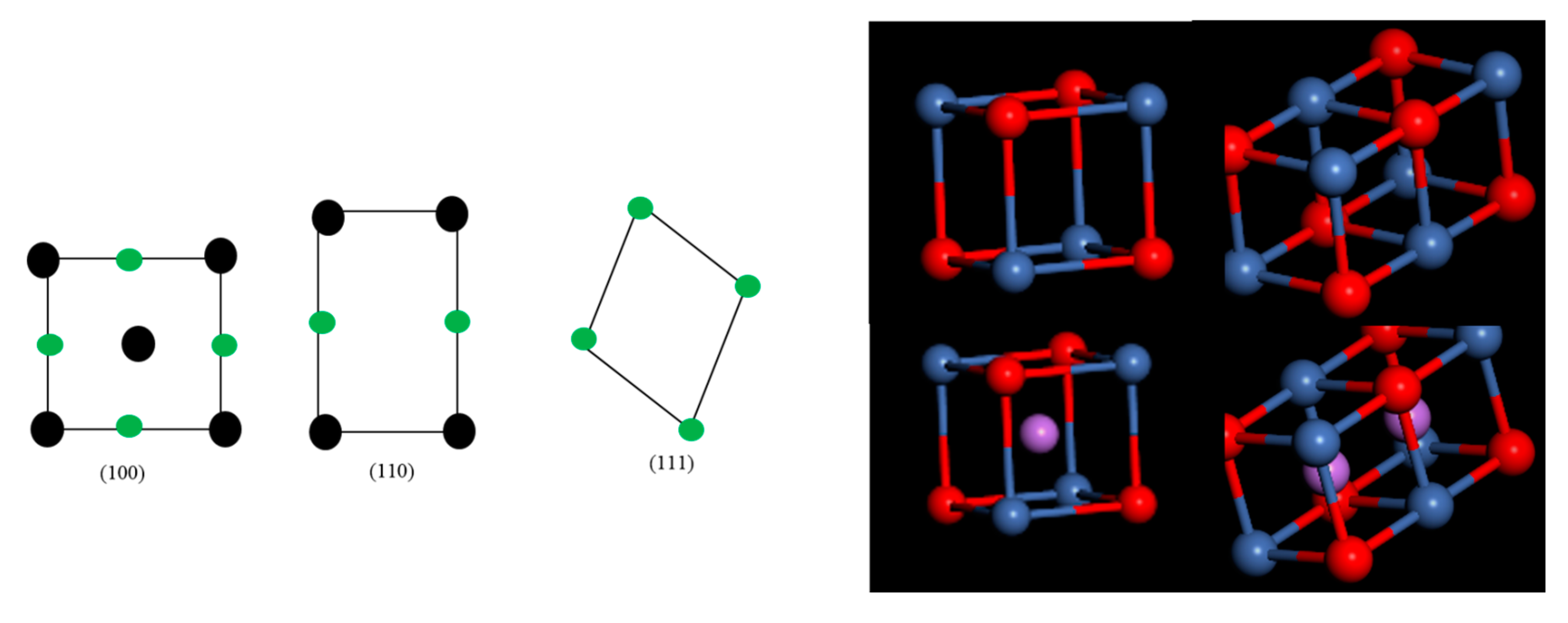
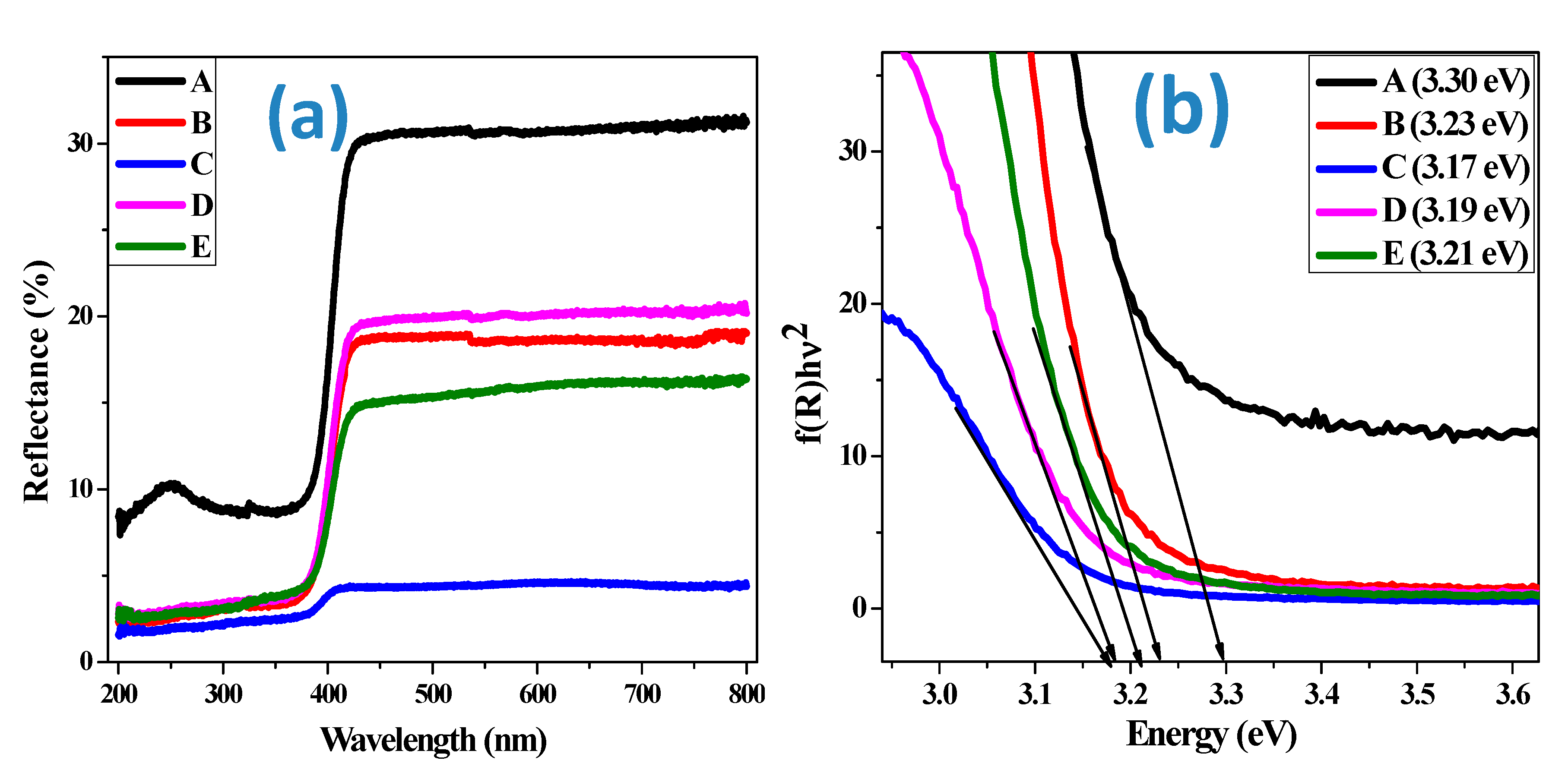
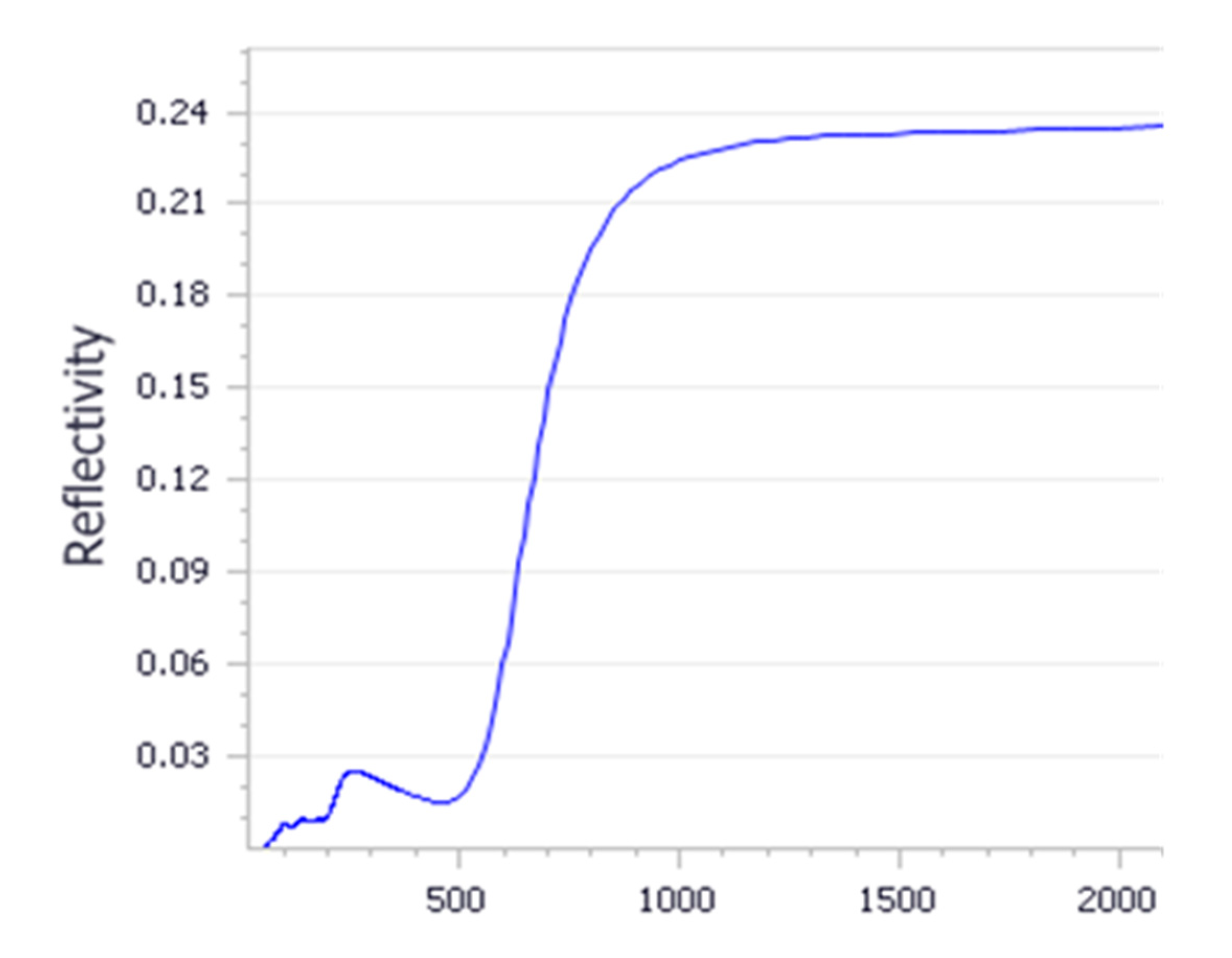
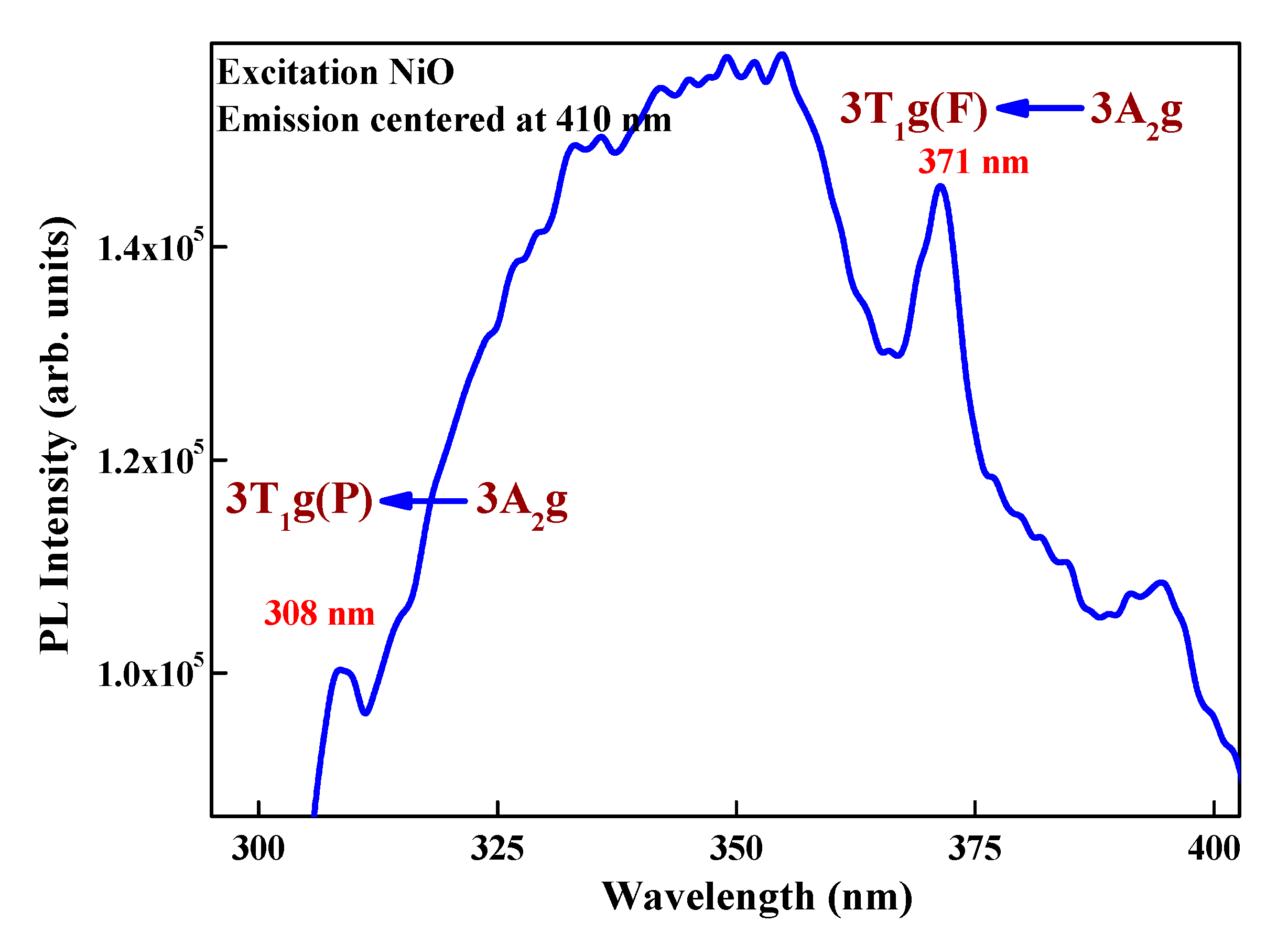

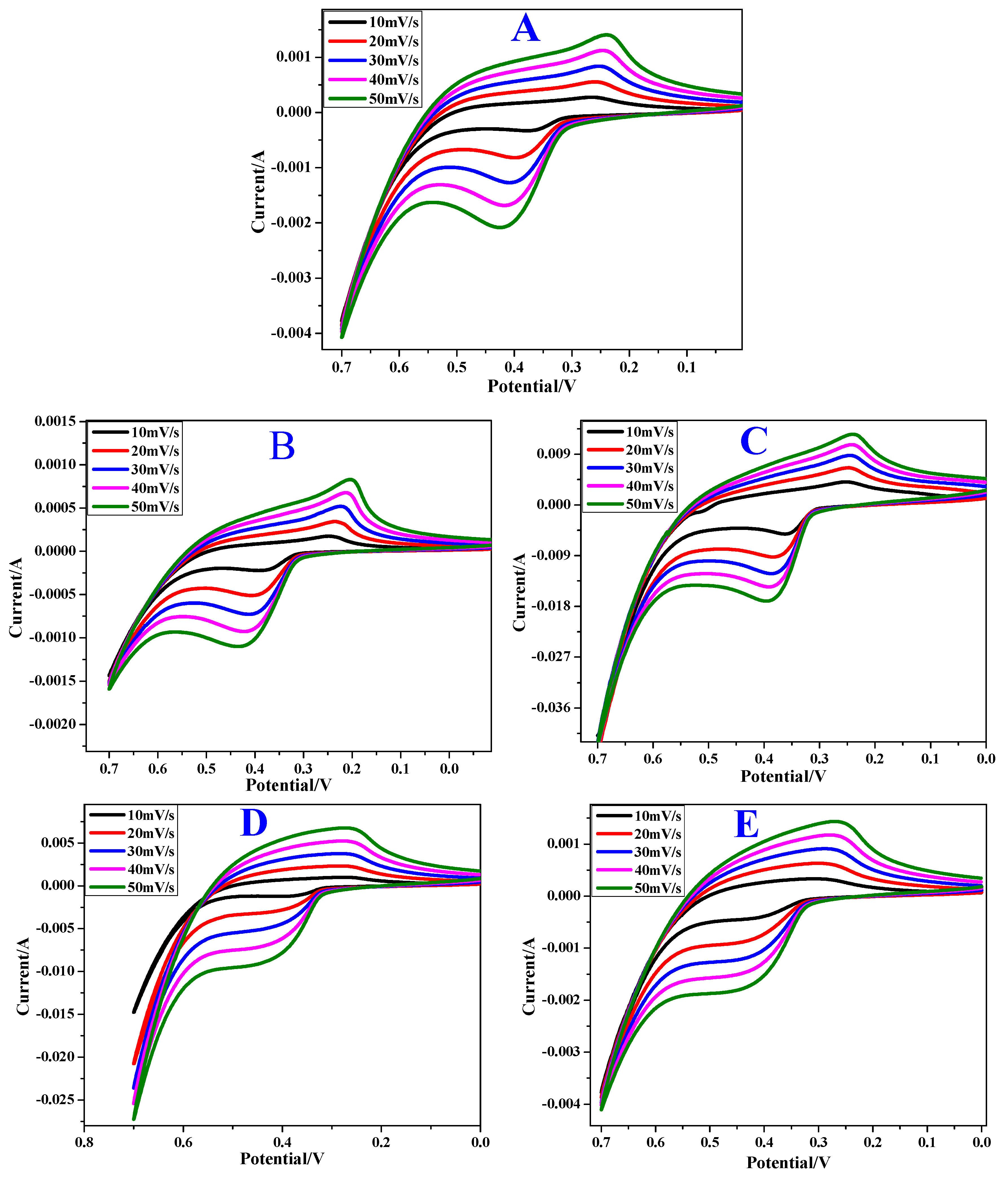

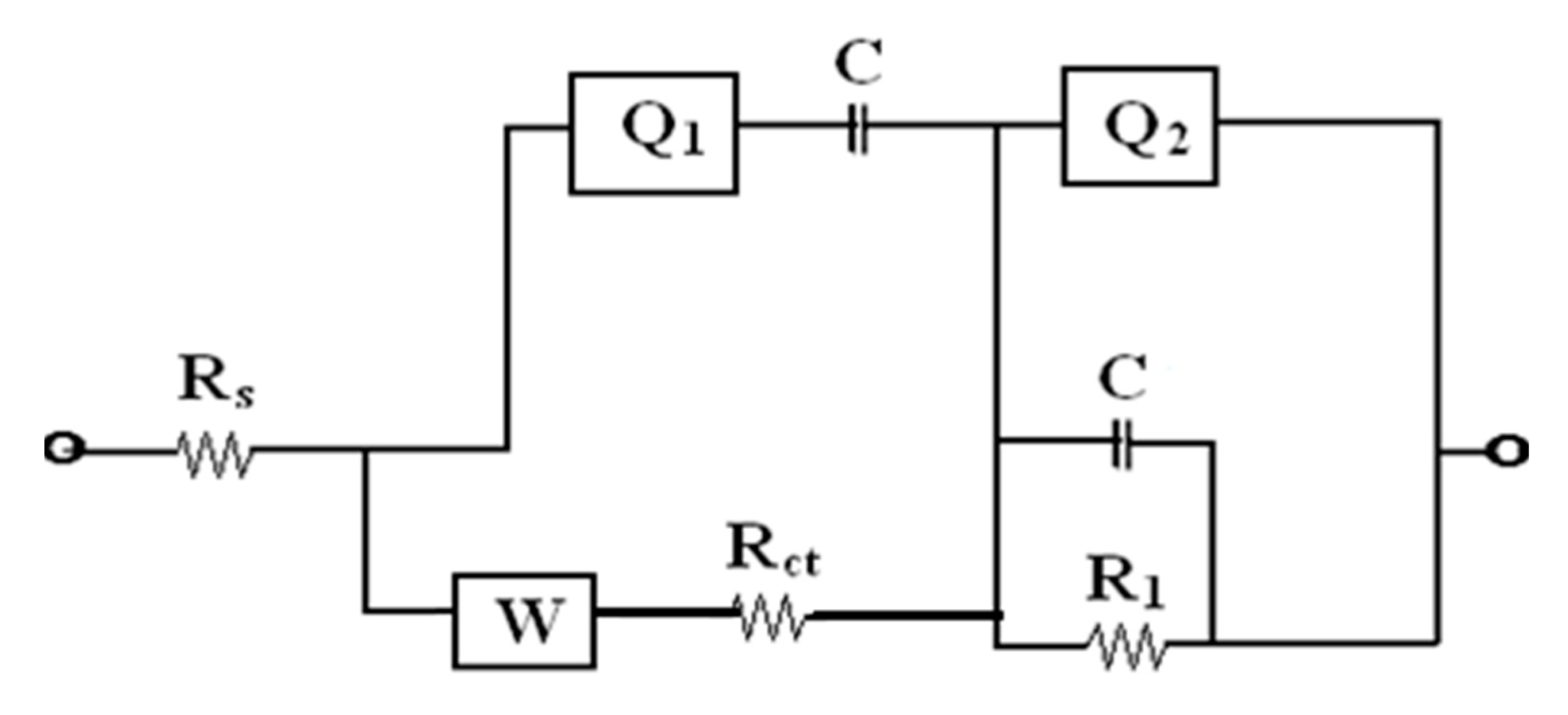
| Sample | Size (nm) |
|---|---|
| A | 3.08 |
| B | 2.47 |
| C | 2.36 |
| D | 2.43 |
| E | 2.80 |
| Name of the Electrode | EO | ER | EO − ER |
|---|---|---|---|
| A | 0.419 | 0.240 | 0.179 |
| B | 0.428 | 0.201 | 0.227 |
| C | 0.392 | 0.238 | 0.154 |
| D | 0.419 | 0.253 | 0.166 |
| E | 0.428 | 0.254 | 0.174 |
| Name of the Electrode | RCt (Ω) | Cdl (F) |
|---|---|---|
| A | 9.146 × 10−3 | 1.147 × 10−4 |
| B | 3.549 × 10−2 | 1.404 × 10−5 |
| C | 5.592 × 10−8 | 1.72 × 10−3 |
| D | 1.277 × 10−4 | 1.239 × 10−5 |
| E | 8.091 × 10−4 | 1.201 × 10−7 |
© 2020 by the authors. Licensee MDPI, Basel, Switzerland. This article is an open access article distributed under the terms and conditions of the Creative Commons Attribution (CC BY) license (http://creativecommons.org/licenses/by/4.0/).
Share and Cite
Bhatt, A.S.; Ranjitha, R.; Santosh, M.S.; Ravikumar, C.R.; Prashantha, S.C.; Maphanga, R.R.; Silva, G.F.B.L.e. Optical and Electrochemical Applications of Li-Doped NiO Nanostructures Synthesized via Facile Microwave Technique. Materials 2020, 13, 2961. https://doi.org/10.3390/ma13132961
Bhatt AS, Ranjitha R, Santosh MS, Ravikumar CR, Prashantha SC, Maphanga RR, Silva GFBLe. Optical and Electrochemical Applications of Li-Doped NiO Nanostructures Synthesized via Facile Microwave Technique. Materials. 2020; 13(13):2961. https://doi.org/10.3390/ma13132961
Chicago/Turabian StyleBhatt, Aarti S., R. Ranjitha, M. S. Santosh, C. R. Ravikumar, S. C. Prashantha, Rapela R. Maphanga, and Guilherme F. B. Lenz e Silva. 2020. "Optical and Electrochemical Applications of Li-Doped NiO Nanostructures Synthesized via Facile Microwave Technique" Materials 13, no. 13: 2961. https://doi.org/10.3390/ma13132961
APA StyleBhatt, A. S., Ranjitha, R., Santosh, M. S., Ravikumar, C. R., Prashantha, S. C., Maphanga, R. R., & Silva, G. F. B. L. e. (2020). Optical and Electrochemical Applications of Li-Doped NiO Nanostructures Synthesized via Facile Microwave Technique. Materials, 13(13), 2961. https://doi.org/10.3390/ma13132961





